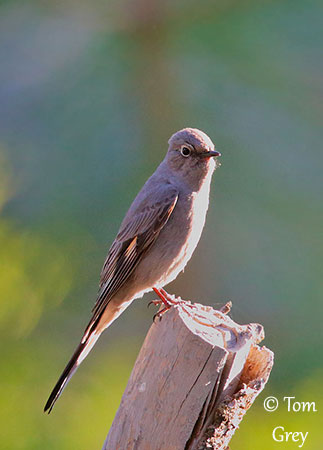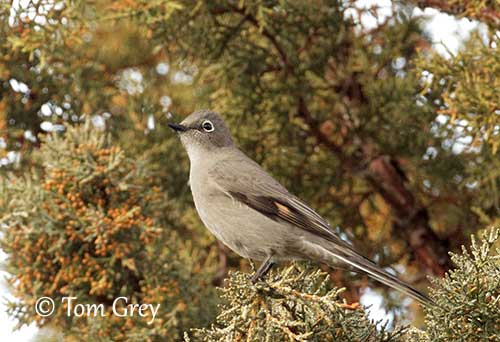
Fr: Solitaire de Townsend
Ang: Townsend’s Solitaire
All: Townsendklarino
Esp: Solitario Norteño
Ita: Solitario di Townsend
Nd: Bergsolitaire
Sd: nordlig solitärtrast
Photographer:
Tom Grey
Tom Grey's Bird Pictures & Tom Grey's Bird Pictures 2
Text by Nicole Bouglouan
Sources:
HANDBOOK OF THE BIRDS OF THE WORLD Vol 10 by Josep del Hoyo-Andrew Elliott-David Christie - Lynx Edicions - ISBN: 8487334725
THRUSHES by Peter Clement and Ren Hathway – HELM - ISBN: 0713639407
BIRDS OF THE GREAT BASIN – by Fred A. Ryser, Jr - University of Nevada Press -ISBN: 0874170796
A GUIDE TO THE BIRDS OF MEXICO AND NORTHERN CENTRAL AMERICA by Steve N. G. Howell, Sophie Webb - Oxford University Press - ISBN: 0198540124
FIELD GUIDE TO THE BIRDS OF NORTH AMERICA - National Geographic Society - ISBN: 0792274512
Bird Web (Seattle Audubon Society)
What Bird-The ultimate Bird Guide (Mitchell Waite)
South Dakota Birds and Birding – (Terry L. Sohl)
SORA - Winter feeding territories in the TOWNSEND'S SOLITAIRE by Roger J. Lederer
A sublingual pouch in TOWNSEND'S SOLITAIRE (Myadestes townsendi) by Jack J. Withrow
On the wild side of the Arkansas River valley
Wikipedia, the free encyclopaedia
Townsend’s Solitaire
Myadestes townsendi
Passeriformes Order – Turdidae Family
INTRODUCTION:
The Townsend’s Solitaire is a slim, long-tailed thrush usually seen alone as its name suggests.
It breeds from C Alaska, S through W Canada and W USA into Mexico. It nests in mountainous areas, usually in open coniferous forests on slopes or in canyons, on or near the ground. It winters from S British Columbia and S Vancouver, to Texas and California, usually at lower elevation.
Like most Turdidae, this species feeds mainly on insects, especially during the breeding season, and mostly berries and small fruits in winter.
The name of the bird pays tribute to John Kirk Townsend (1809-1851), an American ornithologist who collected birds in the western US. The name “solitaire” reflects the solitary behaviour of the species outside of breeding season.
The Townsend’s Solitaire has large range. It is affected by habitat destruction in the winter range, caused by deforestation. During the nesting period, the nest may sometimes be parasitized by small mammals and cowbirds.
But currently, the species is not globally threatened.

DESCRIPTION OF THE BIRD:
Biometrics:
Length: 20-22 cm
Wingspan: 33-37 cm
Weight: 30-35 g
The Townsend’s Solitaire adult has grey head, back, breast and belly, usually slightly darker on the upperparts. On the upperwing, the flight-feathers are dark grey with broad, buff band at base. The tertials have white edges. On the tail, the outermost rectrices are white on the outer web and distal half of the inner web. The other rectrices show a variable amount of white at tip. On the underwing, the broad, white bases of flight-feathers form a pale band visible in flight.
These plumage details are often partly concealed when the bird is perched, but they are conspicuous in flight.
On the grey head, the white eyering is prominent.
The bill is black. The eyes are dark brown. Legs and feet are blackish.
The adult has a sublingual pouch, an enlargement of the epithelium (mucous membrane) of the floor of the mouth. The free tongue is probably used to remove the food from this pouch, behaviour related to mate and chick feeding.
The breeding adults, both male and female, have this peculiar feature, whereas it is absent in non-breeding adults and juveniles.
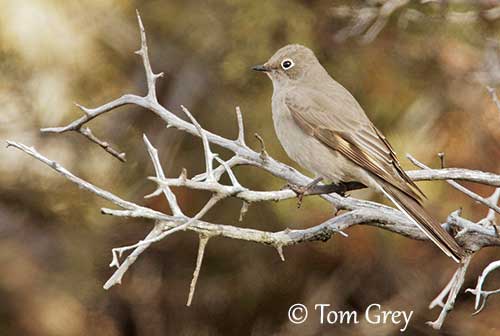
Male and female have similar plumage but the male has longer wings.
The juvenile is dark grey overall with heavy buff and white spotting involving a scaly appearance. On the head, the white eyering is present.
SUBSPECIES AND RANGE:
The Townsend’s Solitaire has two subspecies.
M.t. townsendi (described above) is found in EC and S Alaska and NW to SW Canada, S to W USA.
M.t. calophonus is found in N and C Mexico.
This race is slightly darker than nominate, especially on crown and rump, and the wing patches are more ochraceous.
HABITAT:
The Townsend’s Solitaire breeds mainly in open conifer forests in mountains to beyond the tree-line. In these areas, the nesting-site is established on exposed rocky slopes or dirt banks. In the northern parts of the range, it may breed in burned areas and open scrub habitat near the banks.
During winter, it can be found in semi-open woods and brushy areas, often around junipers that provide abundant food sources such as berries. But it may frequent other areas where fruits are available.

CALLS AND SONGS: SOUNDS BY XENO-CANTO
The Townsend’s Solitaire male has one of the finest voices to be found in these mountains. It utters a long, sweet, warbling song at any time of the year.
The territorial song is a rather prolonged warble-like series of rapid notes on different pitch. These notes are clear, sweet and loud, and follow rapidly each other. This song is also used in courtship.
The male sings from perch, often treetops, dead stub in crown of tall trees, and usually high above the ground. It may leave the perch and still sing while flying and spiralling high in the air, before to plunge to another perch.
During winter, the song is much softer and described as “whisper singing”.
This species gives several types of calls. First a high, clear, mournful whistle “tew” or “heeh” sometimes given in repeated series. Another call given in winter is a harsh “waa” during aggression. A low “chirk” is uttered during food-exchange and the alarm call in summer is a harsh, raspy “kree”.
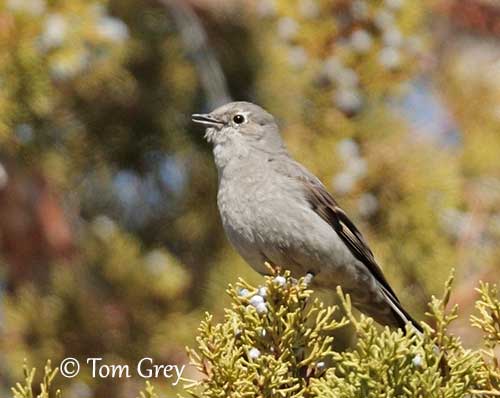
BEHAVIOUR IN THE WILD:
The Townsend’s Solitaire feeds primarily on insects during the breeding season in summer. It catches insects by flycatching from perches on outer tree branches. It sits quietly before to fly out to intercept the passing insects.
It also forages on or near the ground, from scanning perches close to the ground. It also flutters up near tree trunks to catch some insects and spiders.
During winter, the Townsend’s Solitaire feeds mainly on berries and fruits. They move or perform short altitudinal migrations to find sufficient food, especially berries, through the winter.
This species establishes feeding territories on the wintering grounds where chasing, fighting, displaying and singing birds are observed. Then, the defence is more passive. They perch near the treetops and call rather than sing. It defends its territory and supply of juniper berries from other solitaires.
To feed on juniper berries, the bird flies around the outside of the tree and hovers while picking berries from the tip of the branches. This behaviour is named “aerial gleaning”.
The Townsend’s Solitaire is usually seen alone or in pairs, but loose groups of up to ten individuals may gather around good food sources.
They are monogamous and territorial during the breeding season. The male performs a Flight Song Display, starting first on treetop before to fly up to 100 metres above the ground. Then, it circles or zigzags slowly through the air while singing continuously or in several short bouts. This display ends with a steep, zigzagging descent and may last more than 30 minutes.
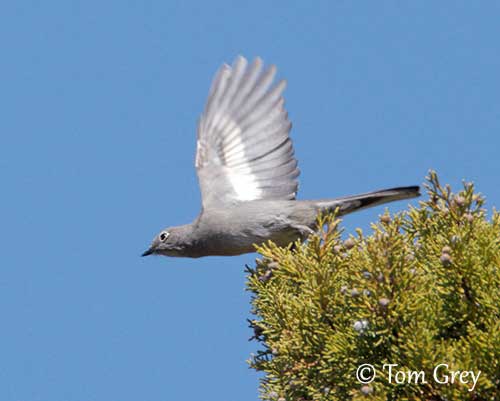
The Flight Song Display is used to attract a mate, and occurs early in the season, when the pair-bond is in progress. In order to maintain this bond, the male performs courtship feeding of female, especially prior to nesting and during the egg-laying.
Prior to the copulation, the male hops back and forth among perches and along the branch where the female is perched. When it is close to her, it stretches the body upwards and extends the head over the back of the female. She may solicit the copulation with the begging display used during courtship feeding.
The Townsend’s Solitaire migrates fairly late in fall and early in spring. The winter range may vary according to food resources, especially berries. This range may extend far S into Mexico.
This species maintains feeding territories in winter, where juniper berries are abundant. It moves to lower elevations, including the Great Plains, northern Mexico and even desert oases.
Only short-distance altitudinal movements to lower elevations in winter are observed. Some populations are resident, especially in Montana where they change from coniferous to juniper woodlands, depending on the season.
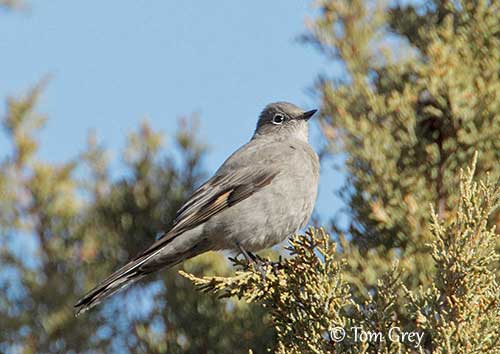
The northernmost breeding birds of nominate race performs long-distance migrations S to California and N Mexico. However, some individuals wintering in California where found breeding slightly higher but within less than three kilometres of the winter areas. The altitudinal migrations occur in mid-March/mid-April and September/October in California.
The flight is rather slow with several wingbeats followed by short glides. The flight pattern may appear often irregular because the bird quickly changes direction.
REPRODUCTION OF THIS SPECIES:
The breeding season takes place from May to July or early August.
The nest is built by the female, usually on or near the ground on a roadside bank or road cut, among roots or under log or stump, or in hollow in dead snag slightly above the ground, less often in rocky crevice in cliff.
The nest is a bulky, loose structure, an open cup made of twigs, grass, pine needles, bark strips and roots, often covered with blackish moss. The cup is lined with finer grass and sedges.
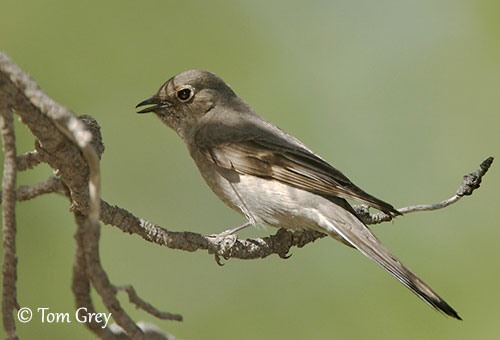
The female lays 3-4/3-5 whitish to pale blue eggs with pale grey and dark brown spots. She incubates alone, because in this species, only the female has a ventral patch. She is fed by the male during this period.
At hatching, the chicks are almost naked with sparse grey natal down. They can stand at six days, fluttering the wings with the bill wide open to receive the food brought by both parents. The young fledge 10-12 days after hatching.
This species produces two broods per season.
PROTECTION / THREATS / STATUS:
The Townsend’s Solitaire has large range but more information is needed concerning the size of the population.
Nest predation is fairly common and an important cause of nest failure. The main predators are squirrels, skunks, cowbirds, and possibly the Steller’s Jay and the American Crow, sometimes snakes too. Deforestation in the winter range may cause habitat destruction.
The population is suspected to be stable, with a small increase in North America in recent decades.
The species is not globally threatened and the Townsend’s Solitaire is currently evaluated as Least Concern.
